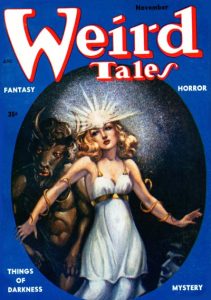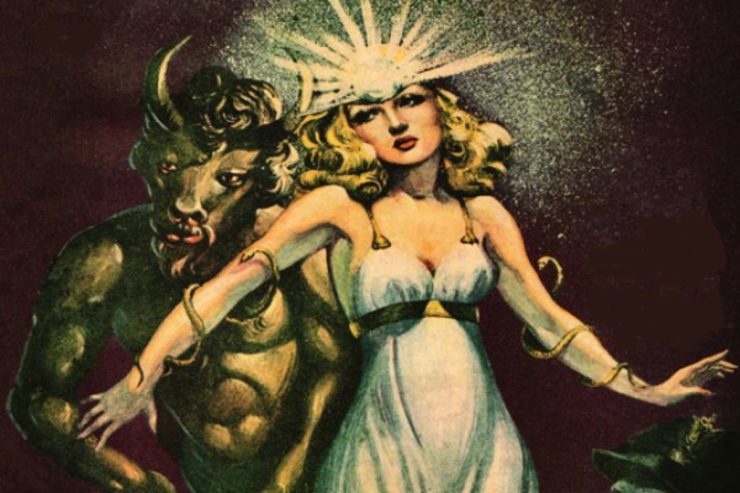 No one defined the look of WEIRD TALES like the magazine’s premier cover artist Margaret Brundage. This talented woman, who dressed (and undressed) countless Seabury Quinn, Robert E. Howard, Jack Williamson, Edmond Hamilton, Paul Ernst, and C. L. Moore characters, was born in Chicago on December 9, 1900.
No one defined the look of WEIRD TALES like the magazine’s premier cover artist Margaret Brundage. This talented woman, who dressed (and undressed) countless Seabury Quinn, Robert E. Howard, Jack Williamson, Edmond Hamilton, Paul Ernst, and C. L. Moore characters, was born in Chicago on December 9, 1900.
After high school, Margaret studied fashion design at the Chicago Academy of Fine Arts. In 1925, she began drawing for the local fashion industry and newspapers, supplementing her income by working for a Prohibition-era speakeasy. In the latter pursuit, she met and married Slim Brundage.
A bouncer and bartender, self-professed hobo, labor organizer, house painter, alcoholic womanizer, and avowed leftist, Slim Brundage was by no means a consistent breadwinner. His commitment to radical causes led to a chaotic home life and, at times, imprisonment. Forced to support herself, her young son, and her sickly mother, Margaret found work as a cover artist for MAGIC CARPET, ORIENTAL STORIES, and WEIRD TALES, beginning in 1932. Farnsworth Wright — the editor of all three Chicago-based magazines — paid her $90 for her cover paintings, most done in pastel on illustration board.
Brundage created 66 covers for WEIRD TALES between 1932 and 1945, making her the most in-demand cover artist for the magazine. Only Virgil Finlay was a close rival. Margaret’s cover art redefined sensuality for the already scandalous pulp market and was eventually targeted by Fiorello La Guardia’s 1938 decency campaign. Censorship and her publishers’ move to New York City substantially reduced the demand for the artist’s talents. Her final magazine cover was a reprint, featured on the November 1953 issue of the digest-sized WEIRD TALES.
Following her pulp career, Brundage continued to paint. She exhibited and sold her work at art fairs and science fiction conventions. She also worked for social justice causes, primarily in the Black community of Chicago’s South Side. She died in poverty in 1976.
Even today, Margaret Brundage’s work remains popular, iconic, and inspirational. It continues to define popular conceptions of pulp fiction, sword & sorcery, and weird fantasy.
(Although remembered primarily for her WEIRD TALES covers — including the November 1953 number — Margaret Brundage painted covers for other Popular Fiction Publishing magazines. She contributed two covers to ORIENTAL STORIES and twice that number to THE MAGIC CARPET MAGAZINE. Brundage also created two covers for GOLDEN FLEECE, a pulp magazine published by Chicago-based Sun Publications.
You’ll find a more detailed discussion of Margaret Brundage’s life and art in Stephen D. Korshak’s and J. David Spurlock’s THE ALLURING ART OF MARGARET BRUNDAGE. You can purchase a copy directly from the publisher — Vanguard Publications — by visiting http://www.vanguardpublishing.com/.
Watch for more on Margaret Brundage at pulpfest.com in the months ahead.)







